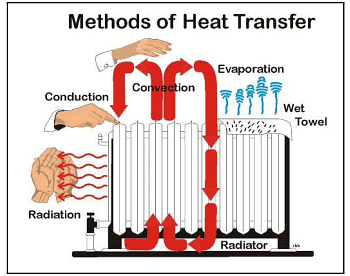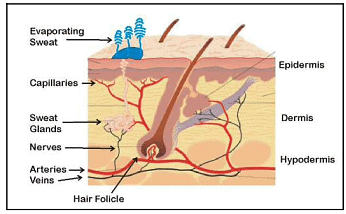Thermoregulatory Physiology | Zoology Optional Notes for UPSC PDF Download
Thermoregulation and Heat Transfer in the Human Body
Introduction: Human beings are essentially tropical animals, adapted to function within a narrow temperature range to maintain vital organs like the heart, lungs, and brain at an average core temperature of 98.6°F. This article delves into the mechanisms of thermoregulation, highlighting how the body dissipates and retains heat to survive in various environments.
Body as an Engine
Comparing the body to an engine, it utilizes food to fuel muscles and the brain. The brain, the body's control center, primarily seeks to maintain warmth (98.6°F) and a steady supply of sugar for optimal functioning. Failure to meet these criteria prompts the brain to initiate corrective measures.
Muscles and Heat Generation
Muscles, including the heart, play a crucial role in bodily functions, generating both heat and waste products. Efficient heat dispersal and waste elimination are essential for proper functioning.
Thermoregulation of the Body
The body's ability to regulate temperature is vital for survival. Thermoregulation involves dissipating, gaining, and reducing the loss of heat. Four heat transfer methods—conduction, convection, radiation, and evaporation—are explored.
- Conduction: Heat transfer through or between solids, illustrated by touching a warm radiator or sitting on a cold rock.
- Convection: Heat transfer through fluid or gas circulation. Insulation against convection involves creating dead air spaces to hinder the circulation process.
- Radiation: Energy transfer through waves radiating from an emitting substance, as seen in a radiator.
- Evaporation: The conversion of a liquid to a gas, cooling the environment. Sweating is the body's way of cooling itself.

Maintaining Core Temperature
The body's core temperature (heart, lungs, brain) is ideally kept at 98.6°F. It balances heat generation, gaining external heat, and retaining body heat through insulation. Shivering exemplifies the body generating heat to maintain its temperature.
Adapting to Environmental Changes
The body adjusts the mix of gaining, losing, and retaining heat to stay comfortable. It accomplishes this through voluntary and brain-suggested actions. For instance, stepping into the sun gains radiating heat, while moving into the shade dissipates it, showcasing the body's dynamic response to temperature changes.
Understanding these thermoregulatory processes provides insights into how the body copes with temperature variations, aiding in discussions on hypothermia, hyperthermia, and overall environmental adaptation.
Thermoregulation and Compensatory Processes: Understanding Equilibrium
Thermal Equilibrium in a Room
Consider a person standing in a room heated to 70°F, with an equilibrium established between convection losses and waste heat production. If the thermostat is lowered to 65°F, convection losses increase, upsetting the equilibrium. The body has two options to restore balance: increase heat production or enhance insulation. Activities like walking generate extra waste heat temporarily, while adding clothing provides insulation. Clothing, including a hat, can effectively retard convection losses, restoring comfort and maintaining the body's core temperature at 98.6°F.
Sweating Process
Under normal circumstances, sweating is the primary method the body uses to cool itself. The process involves heat production, shunting warm blood to the skin, and water secretion through sweat glands. Evaporation of sweat absorbs energy from the skin, cooling it, and subsequently cooling the blood in capillaries. The cooled blood returns to the body's core or muscles, repeating the cycle. Sweating is vital for heat dissipation, especially in hot environments or during intense exercise.

Clothes and Shelter in Thermoregulation
Shelter, in the context of thermoregulation, encompasses various forms, including clothing, campsites, cars, and homes. Clothing, as immediate shelter around the body, acts as insulation. Shelter, viewed as a continuum extending outward from the body, plays a crucial role in temperature regulation.
Compensatory and Decompensatory Processes
Thermoregulation involves compensatory and decompensatory processes. Compensatory processes aim to maintain homeostasis by adjusting to thermal stresses through increased heat production, altering energy reception, or changing insulation. Decompensatory processes occur when the body can no longer compensate, leading to shutdown. Heat exhaustion and shivering are compensatory, while heat stroke and hypothermia are decompensatory.
Summary of Thermoregulation
Thermoregulation is the body's process of maintaining its operating temperature around 98.6°F. It involves compensatory mechanisms seeking homeostasis, utilizing conduction, convection, radiation, and evaporation. The body can adjust heat production, gain or lose external heat, and change insulation levels to maintain its optimal operating temperature. Activities such as exercise, shivering, and modifying clothing contribute to this dynamic process.
|
181 videos|351 docs
|
















